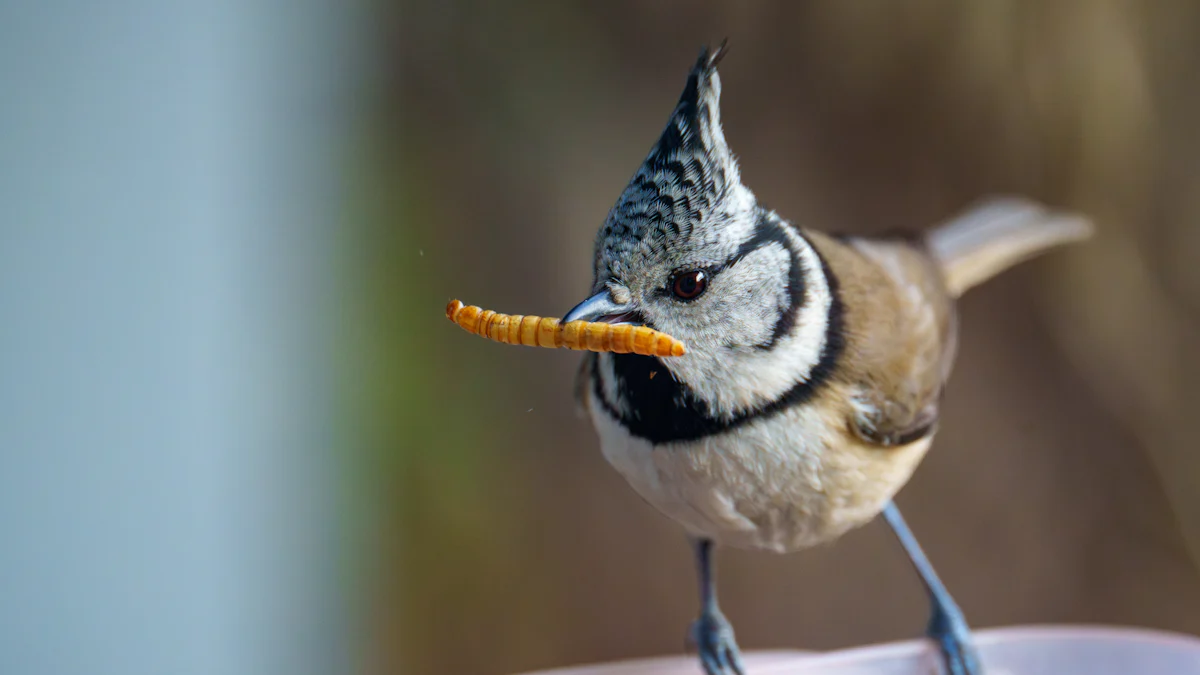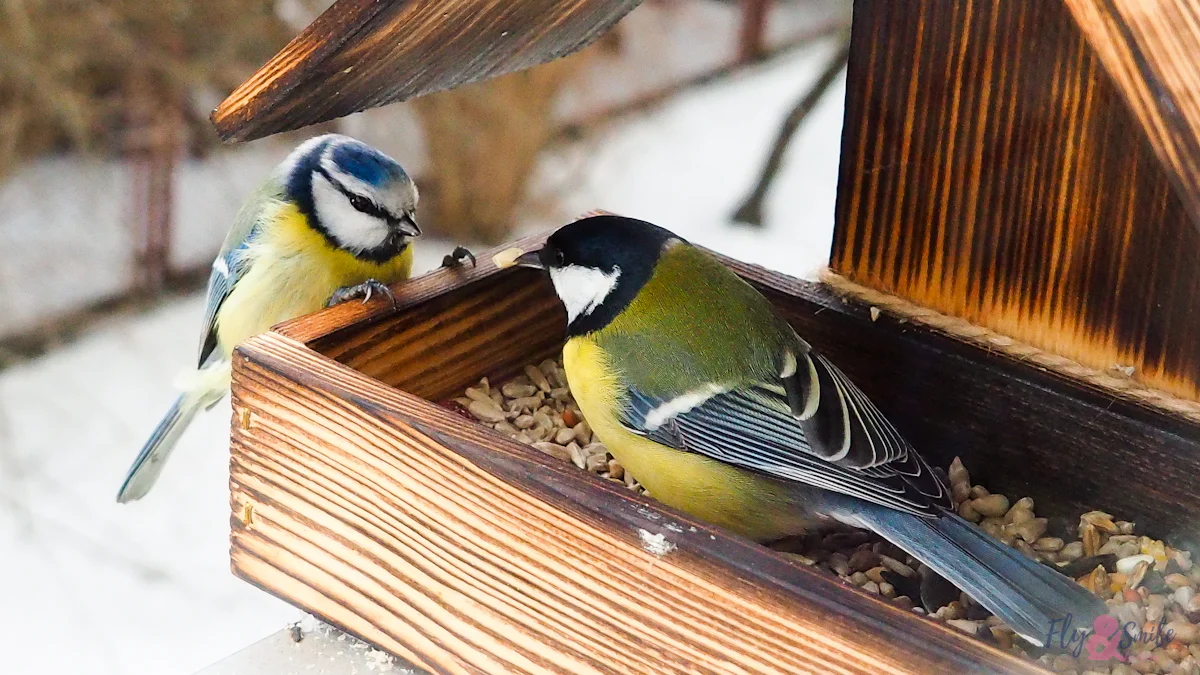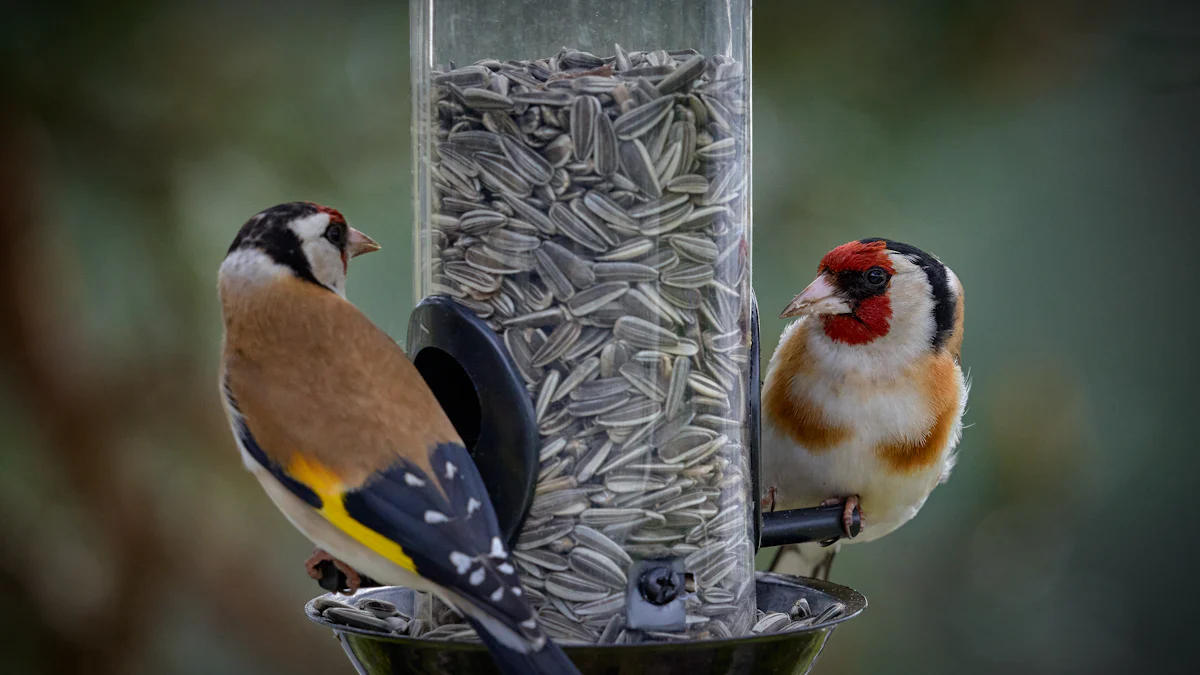
If you’re looking for an easy way to support your feathered friends, dried mealworms for birds are a fantastic choice. Packed with nutrients, they’re a high-protein snack that helps birds stay healthy and active. Mealworms are especially helpful during winter when birds need extra energy to stay warm. They’re also a lifesaver for parent birds during nesting season, providing the fuel they need to care for their chicks.
Here’s a quick look at the key nutrients in dried mealworms and how they benefit birds:
| Nutrient Type | Benefits for Birds |
|---|---|
| High in protein | Supports feather production and overall vitality. |
| Rich in B vitamins | Boosts metabolism and energy levels. |
| Contains minerals | Essential for various bodily functions. |
| Contains amino acids | Vital for growth and repair. |
By adding mealworms to your bird-feeding routine, you’ll attract a variety of species while giving them the nutrition they need to thrive.
Key Takeaways
- Dried mealworms are a protein-rich food that helps birds stay healthy, especially in winter and nesting times.
- Adding dried mealworms to birdseed makes a healthy mix that brings many bird types.
- Keep dried mealworms in a cool, dry spot to stay fresh and safe for birds to eat.
Benefits of Dried Mealworms for Birds

High Protein Content
Protein is one of the most important nutrients for birds, and dried mealworms are packed with it. This makes them a fantastic choice for supporting growth, repairing tissues, and keeping birds active. Compared to many other bird food options, dried mealworms stand out because of their high protein levels. They’re especially helpful for birds during molting seasons when they need extra protein to grow new feathers.
If you’ve ever wondered why birds seem to flock to mealworms, it’s because they instinctively know how beneficial they are. Protein gives them the energy to fly, forage, and even care for their young. By adding dried mealworms to your feeding routine, you’re giving birds the fuel they need to thrive.
Rich in Essential Nutrients
Dried mealworms for birds aren’t just about protein—they’re also loaded with other essential nutrients. They’re rich in B vitamins, which help birds maintain a healthy metabolism and stay energized. Plus, they contain minerals and amino acids that are vital for overall health. These nutrients play a key role in keeping birds strong, especially during challenging times like winter or breeding seasons.
When you offer dried mealworms, you’re providing a well-rounded snack that supports their health in multiple ways. It’s like giving them a superfood that’s easy to eat and digest.
Suitable for Year-Round Feeding
One of the best things about dried mealworms is their versatility. You can feed them to wild birds all year round. They’re particularly valuable in winter when birds need high-protein and high-fat foods to stay warm. During nesting season, they’re a lifesaver for busy parent birds who need extra energy to care for their chicks.
Mealworms are also easy to store and prepare, making them a convenient option for you. Whether it’s a hot summer day or a chilly winter morning, you can count on dried mealworms to keep your feathered visitors happy and healthy.
Types of Birds That Eat Dried Mealworms

Common Backyard Birds
You might be surprised by how many backyard birds love dried mealworms. These little treats are a favorite for many species that visit your yard. Some of the most common ones include:
- Bluebirds
- Robins
- Woodpeckers
- Chickadees
- Orioles
If you’re looking for a more detailed list, here are some other birds that enjoy mealworms:
- Bluebirds
- Chickadees
- Thrushes
- Titmice
- Wrens
- Nuthatches
- Kinglets
Adding dried mealworms for birds to your feeder is a great way to attract these species. You’ll not only help them stay healthy but also get to enjoy their lively presence in your yard.
Seasonal Visitors
Certain birds only visit during specific times of the year, and mealworms can make your yard a must-stop destination for them. In spring and summer, you might see migratory birds like orioles and warblers stopping by for a snack. During the colder months, winter visitors such as juncos and sparrows may appreciate the extra protein and energy mealworms provide.
By offering mealworms year-round, you can cater to both your regular feathered friends and those seasonal visitors passing through. It’s a simple way to make your yard a welcoming haven for birds, no matter the season.
Birds That Feed Their Young
Parent birds work tirelessly to feed their chicks, and dried mealworms can make their job a little easier. Chickadees, for example, often use mealworms as a quick and nutritious food source during feeding trips to the nest. While they still gather caterpillars and other insects for a balanced diet, mealworms provide a reliable supplement.
By offering mealworms, you’re helping parent birds stay energized and ensuring their chicks get the nutrition they need to grow strong. It’s a small gesture that makes a big difference during the busy nesting season.
How to Feed Dried Mealworms to Birds
Choosing the Right Feeder
Picking the right feeder can make a big difference when offering dried mealworms to birds. You’ll want a feeder with tall sides to keep the mealworms from spilling out. A roof or baffle is also a smart choice since it protects the food from rain. Nobody likes soggy mealworms, right? Drainage holes are another must-have feature. They prevent water from pooling and keep the mealworms fresh. If you’re worried about pests like squirrels or larger animals, look for feeders with tamper-resistant designs. These features ensure your feathered friends get their mealworms without any interruptions.
Mixing Mealworms with Birdseed
Mixing dried mealworms with birdseed is a simple way to create a nutritious blend that birds love. This combo offers a variety of benefits:
- High in protein, which supports muscle development and feather growth.
- Rich in B vitamins to boost metabolism.
- Packed with minerals and amino acids for overall vitality.
This mix can attract a wide range of birds, including bluebirds, robins, and woodpeckers. These species especially appreciate the high protein content during breeding season. By combining mealworms with birdseed, you’re giving birds a balanced meal that keeps them coming back for more.
Offering Mealworms in Different Ways
Sometimes, a little creativity goes a long way. You can moisten dried mealworms slightly to make them more appealing to birds. Soaking them in lukewarm water for a few minutes works wonders. This trick mimics the texture of live insects, making the mealworms irresistible. You can also scatter them on the ground or place them in a dish for ground-feeding birds. Experiment with different methods to see what works best for the birds in your yard.
Mealworms can be fed to wild birds all year round, but they’re particularly beneficial during winter when high-protein and high-fat foods are most valuable. They’re also great during nesting season for keeping busy parent birds energized.
Storage and Preparation of Dried Mealworms
Proper Storage Techniques
Storing dried mealworms properly ensures they stay fresh and nutritious for your feathered friends. The key is to control temperature, humidity, and airflow. Keep them in a cool spot, ideally between 40-50°F (4-10°C). This slows down any potential degradation. A moderately dry environment is also essential. If you notice any moisture, place a paper towel in the container to absorb it.
For storage, plastic bins with lids and small ventilation holes work best. These allow airflow while keeping pests out. Adding bedding material like wheat bran or oatmeal can help insulate the mealworms and maintain their quality. If you have a surplus, freezing them at temperatures below -15°C is a great option. This method keeps them fresh for over six months.
Rehydrating Mealworms for Better Palatability
Rehydrating dried mealworms can make them even more appealing to birds. Soaking them in lukewarm water for a few minutes softens their texture, making them easier to digest. Birds love the enhanced flavor and scent, which mimic live insects. This trick is especially useful during nesting season when parent birds need quick, nutritious food for their chicks.
If you’ve never tried rehydrating mealworms, give it a shot. You’ll likely notice more birds flocking to your feeder, eager to enjoy the treat.
Preventing Spoilage
Spoiled mealworms can harm birds, so it’s important to store them correctly. Always keep them in a cool, dry place, away from sunlight. Airtight containers are your best friend here. They prevent moisture from seeping in and protect the mealworms from light degradation.
For long-term storage, freezing is a reliable option. Just make sure the container is airtight to avoid freezer burn. Monitor the temperature where you store them. The ideal range is 60°F to 75°F (15°C to 24°C). By following these steps, you’ll keep your mealworms fresh and safe for your feathered visitors.
Potential Risks and Precautions
Avoiding Overfeeding
Feeding birds is rewarding, but overfeeding dried mealworms can cause problems. Birds need a balanced diet, and too many mealworms can lead to nutritional imbalances. They might miss out on other essential foods like seeds, fruits, or insects. Overfeeding can also make birds overly reliant on mealworms, reducing their natural foraging instincts.
To avoid these issues, offer mealworms in moderation. Think of them as a treat rather than the main course. A small handful a day is usually enough for most backyard birds. By keeping portions reasonable, you’ll help birds stay healthy and maintain their natural behaviors.
Preventing Pest Issues
Storing dried mealworms properly is key to keeping pests away. Pests like ants, beetles, or even rodents can be attracted to improperly stored mealworms. To prevent this, follow these tips:
- Store mealworms at 40-50°F (4-10°C) to keep them dormant.
- Use a container with small ventilation holes for airflow.
- Keep the storage area dry to avoid mold growth. A paper towel can help absorb excess moisture.
- Check your mealworms regularly for signs of spoilage or pests.
- Rotate your stock, using the oldest mealworms first to minimize waste.
By taking these steps, you’ll ensure your mealworms stay fresh and pest-free, making them safe for your feathered visitors.
Ensuring Mealworm Quality
The quality of the mealworms you feed birds matters. Spoiled or low-quality mealworms can harm birds, so always inspect them before use. Look for signs of mold, an unusual smell, or discoloration. If you notice anything off, it’s best to discard them.
Rehydrating dried mealworms can also improve their quality. Soak them in lukewarm water for a few minutes to soften their texture. Birds find rehydrated mealworms easier to eat and digest, especially during nesting season. This small step can make a big difference in how much birds enjoy their treat.
By ensuring mealworm quality, you’re not just feeding birds—you’re supporting their health and well-being.
Feeding dried mealworms for birds is a simple way to support their health while enjoying the beauty of nature. These protein-packed snacks attract a variety of fascinating species to your yard, making birdwatching even more exciting. Pairing mealworms with other food sources and fresh water creates a welcoming haven for birds year-round. Whether it’s winter or nesting season, mealworms provide the energy birds need to thrive. By following this guide, you’ll create a vibrant, bird-friendly space that brings joy to both you and your feathered visitors.
FAQ
Can I feed dried mealworms to birds all year round?
Absolutely! Mealworms are perfect year-round. They’re especially helpful in winter for energy and during nesting season to keep parent birds energized.
How many mealworms should I offer daily?
A small handful works best. Think of mealworms as a treat, not the main course. This keeps birds healthy and encourages natural foraging.
Do I need to rehydrate dried mealworms before feeding?
Not always, but soaking them in lukewarm water makes them softer and more appealing. Birds love the texture, especially during nesting season.


